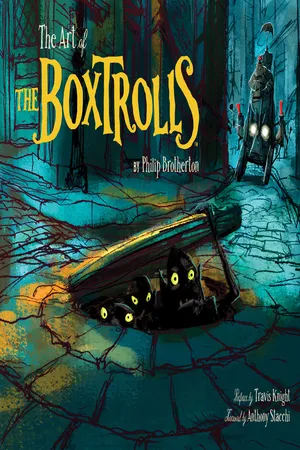![]()
Chapter 1
Roaming
The Streets
“The Boxtrolls is a hierarchical story about the people from below and the people above and a man who wants to climb the social ladder. A vertical city just made sense.”
Upon reading the script, a film director typically begins piecing together a vision of how he or she imagines the finished film to look. Each director’s process might be different, but the primary job is always the same: to express that vision as clearly as possible so that the rest of the filmmaking crew can help make that vision a reality. Armed with strong ideas of what he wanted The Boxtrolls to look like, Stacchi went in search of imagery that “justified and supported” his ideas. “In my experience,” he says, “good research usually ends up reaffirming the vision you already have, and helps explain your vision to others.” The German Expressionist art movement of the early twentieth century conveyed many of the key components of Stacchi’s early vision for The Boxtrolls. Marked by bold colors and abstract shapes, Expressionism favored the artist’s inner emotional landscape over external physical landscapes, and paintings of this era often reflected political or religious attitudes of their time. Many films and filmmakers through the years have drawn from Expressionism’s inspirational waters. One of the first and most widely recognized was Robert Wiene’s The Cabinet of Dr. Caligari (1920). Directors Alfred Hitchcock, Orson Welles, and Ridley Scott, among others, also borrowed freely from this style.
For Stacchi, it was mostly director David Lean’s evocative use of light and shadow in his black-and-white film version of Oliver Twist (1948) along with the sewer chase scenes from Carol Reed’s The Third Man (1949) that best demonstrated his vision for The Boxtrolls. “Once I had an inkling of what I wanted the story to look like,” Stacchi says, “I knew immediately who I wanted to take the first crack at design.”
He turned to renowned French graphic novelist Nicolas de Crécy, whose highly detailed illustrative depictions of urban European life had precisely the right mixture of gritty realism and dark fantasy. “I’d never met de Crécy, but I loved his artwork,” Stacchi explains. “His organic use of lines, patterns, and shapes gives his cityscapes the same complexities that you find in nature. So we reached out to him for a few key images.” It was a working relationship that was not without some challenges. “I don’t speak French,” Stacchi notes, “and his English isn’t great; so all our communications had to be translated.” In the end, it was well worth the effort, because the handful of illustrations provided by de Crécy had unlocked the door to production design for the entire film.
Michel Breton · colored pencil & digital
With de Crécy’s key images in hand, Stacchi went in search of another concept illustrator who could both emulate and build upon the graphic novelist’s style, and apply it to all of the film’s principal environments. To his amazement, he didn’t even have to leave the building. French Canadian artist Michel Breton had recently finished work on LAIKA’s first film, Coraline, and was ready for a new project. Prior to Coraline, he’d made a splash in the animation world with his contributions to 2003’s The Triplets of Belleville. Upon learning of Breton’s connection to The Triplets of Belleville and seeing how naturally his style dovetailed with de Crécy’s, Stacchi knew he’d found his illustrator.
Breton accepted the job and enthusiastically embraced Stacchi’s vision for the film. “When I read the script and started drawing,” he says, “my approach was to think about ...












